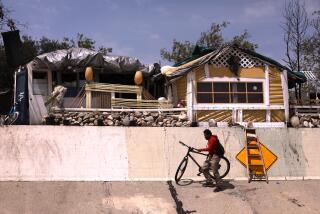The first of L.A.âs temporary shelters is about to open. âWe have to do something today,â Garcetti says
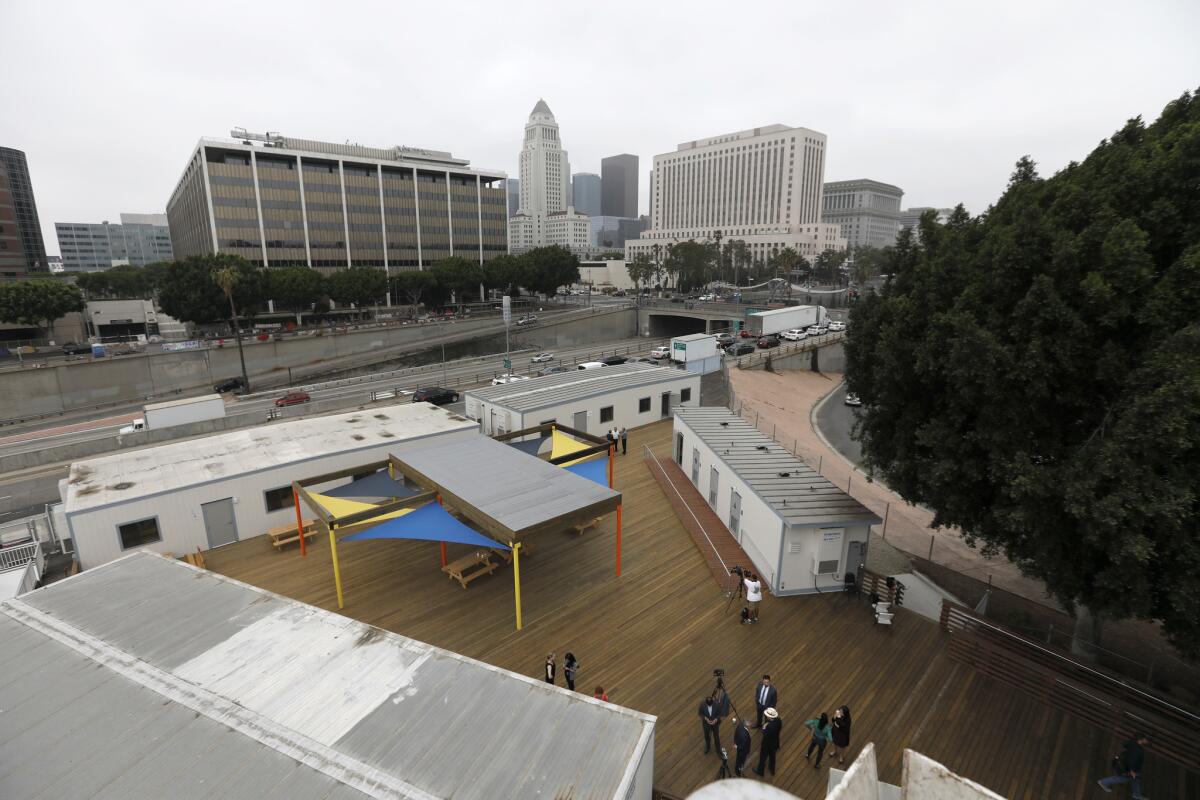
With a cluster of trailers on a downtown parking lot, the city of Los Angeles is launching the first in a string of multimillion-dollar shelters designed to relieve hundreds of homeless people while sweeping away squalid street camps that threaten Mayor Eric Garcettiâs political legacy.
The $2.4-million shelter is set to open Monday for 45 homeless people in the El Pueblo historic district, part of the cityâs A Bridge Home crisis housing project.
Officials hope to open 15 bridge housing facilities by mid-2019, with a boost from one-time state homeless aid that could bring the programâs budget to $75 million. Some 13 sites are in formal review, and others are in preliminary stages or may be funded separately.
âThereâs no question that homes are the cure for homelessness,â Garcetti said at a news conference Wednesday. âBut we canât just wait for that day theyâll have a permanent apartment. We have to do something today.â
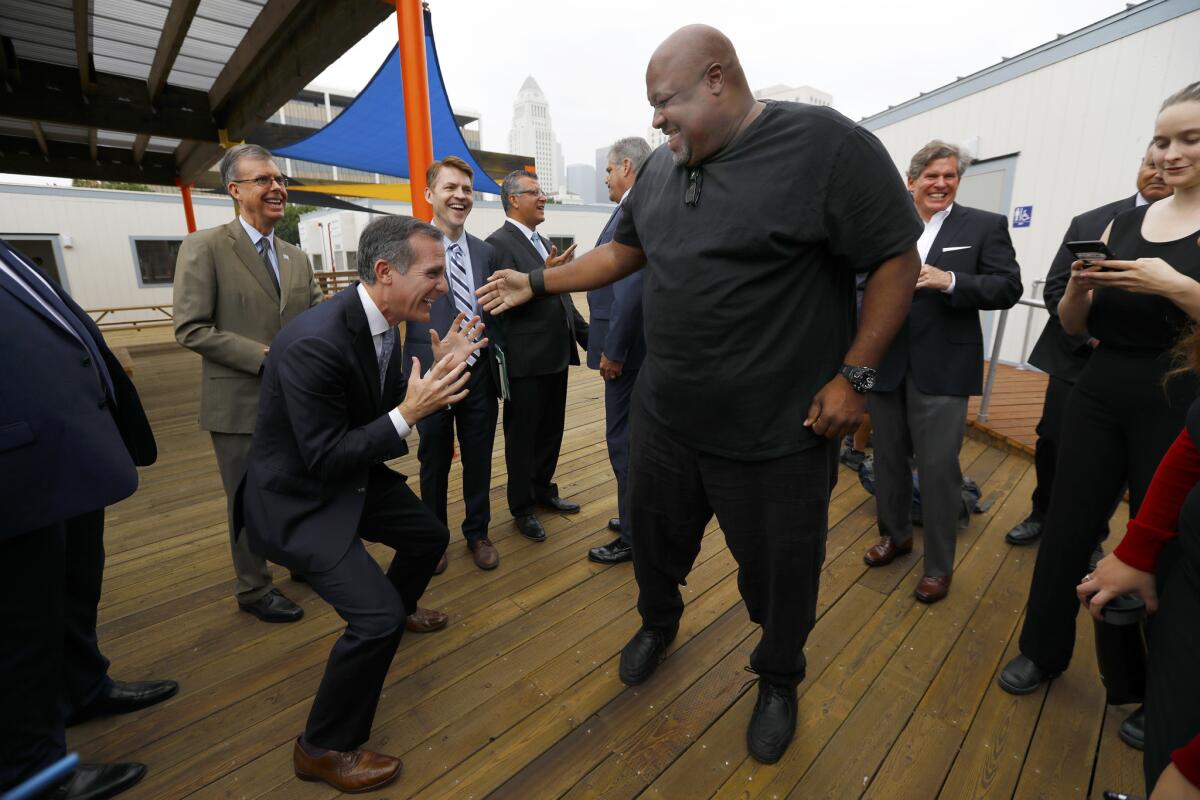
The mayor has promised enhanced cleanup and âenforcement zonesâ to keep the shelters from attracting even more of the ragtag tents that have become a common sight in El Pueblo and other neighborhoods since homelessness exploded in the city four years ago.
The U.S. 9th Circuit Court of Appeals ruled Tuesday that homeless people in California and other Western states cannot be prosecuted for sleeping in public when shelters are lacking. Even with the new facilities, Los Angeles will not have enough shelter beds for all 23,000 people living in city streets, canyons and alleys.
Garcetti said the city already abides by the decision and does not arrest homeless people for sleeping overnight in the streets.
Related: Advocates hail ruling that restricts criminalizing homeless sleeping Âť
Late last week, a group of 50 homeless service providers objected to the enforcement zones, saying they would displace and traumatize homeless people and shatter their trust.
âWe must do our best to meet their basic needs, not continue the failed policy of moving them from place to place through enforcement,â the Westside Coalition said in a letter to the mayor and council offices.
Garcetti said increased enforcement, which in the past has been sporadic, would enhance public safety and protect homeless people from predators. The city also plans increased outreach to connect homeless people in the surrounding areas to public services and, eventually, housing.
People can continue to sleep on sidewalks overnight but must limit their belongings and take their tents down in the daytime, officials said.
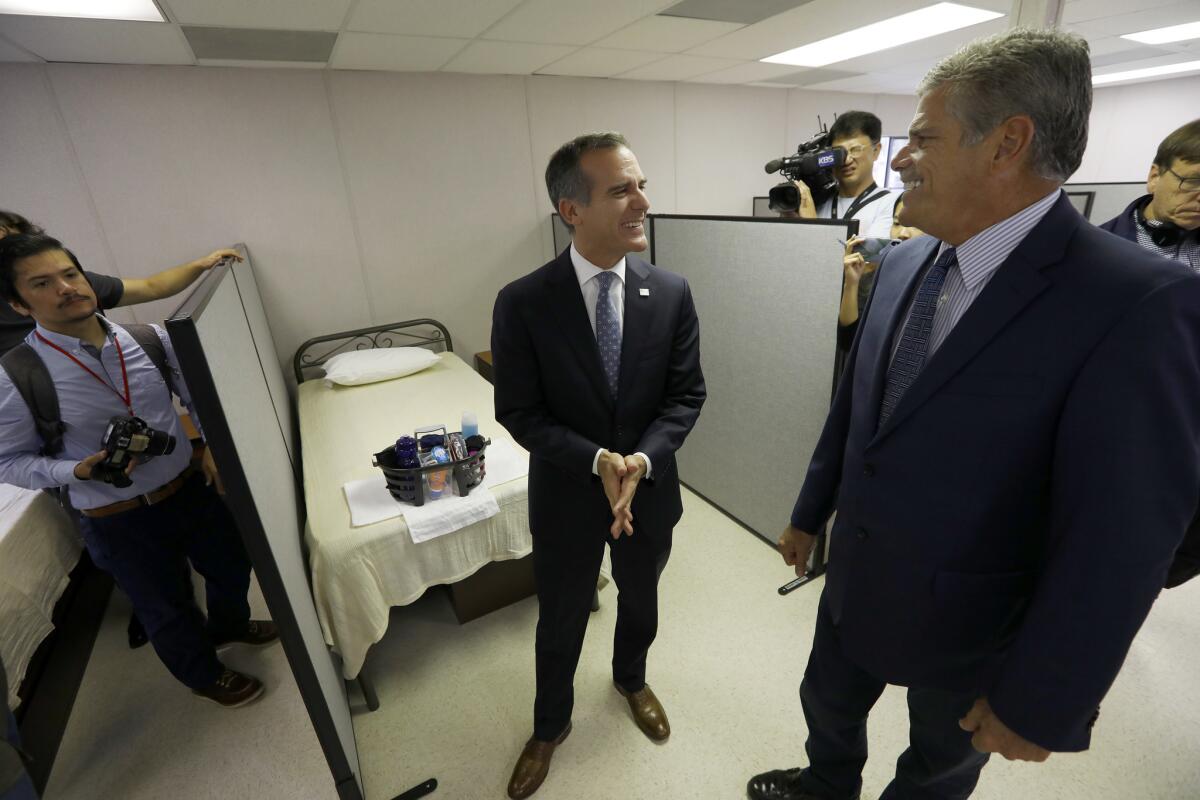
The shelter plan comes at a critical juncture for Garcetti, who is spreading campaign contributions nationwide to forge alliances with Democratic Party leaders as he considers a bid for the White House. The city is also looking forward to international attention as it prepares to host the 2028 Summer Olympics.
L.A. traditionally has left emergency shelter to the 100-year-old missions and other social service agencies on skid row, in South Los Angeles and elsewhere. Authorities in recent years shut down transitional beds while they focused on rolling out the $1.2-billion permanent housing construction program and services voters approved in the last two years.
In January, Garcetti changed course, dedicating $20 million to the shelter program. The City Council added $10 million, and the city is finalizing its application for $45 million in state homeless aid that could be used for shelters, housing, drop-in centers, storage bins and parking lots for homeless people who sleep in their vehicles.
Many local and national homeless advocates say the shelters are overdue, while others say the money would be better spent on rent vouchers or other direct aid.
âRight now we see a huge amount of sex trafficking of women and kids; we need shelters to protect them from the elements and to protect them from violence,â said Mel Tillekeratne, the founder of the Monday Night Mission, a group that feeds people on skid row.
But the run-up to the shelters has been rocky. Costs for the El Pueblo shelter escalated to $2.4 million, mass demonstrations killed a proposed shelter site in Koreatown and protests are simmering in Venice, Harbor City and other neighborhoods.
All but two council members â Nury Martinez and Gil Cedillo â have publicly identified possible shelter or storage sites in their districts, mostly on lots owned by the city, Metro or public utilities.
Future sites are likely to house homeless people in platform tents, with showers and bathrooms in adjoining trailers, said Matt Szabo, Garcettiâs deputy chief of staff. The mayor said the city might also convert warehouses and other existing buildings into shelters.
Garcetti has said he believes shelter costs can come down, but a proposed 70-person shelter in Hollywood will cost $3 million, according to Councilman Mitch OâFarrellâs office. Many of the sites still must undergo community review.
Angelina Valencia, a spokeswoman for Councilman Curren Price, said he would hold community meetings where residents can provide feedback on a proposed site âif and when it is determined [to be] technically a viable option.â
The El Pueblo shelter was designed with input from longtime service providers to eliminate barriers that have made shelters unappealing, including sobriety checks, Garcetti said. Homeless people can stay with their partners and bring in their pets.
The shelters will have bathrooms, showers and laundry facilities and stay open around the clock.
On-site staff will help residents try to find permanent housing in three to six months, but there is no deadline.
While some people living in El Puebloâs dozens of tents were excited about the shelter, others were dismissive. Javier Franco, 50, who has lived on El Pueblo streets for 10 years, said that the beds arenât private and that he doesnât want to live with people who use methamphetamine or other drugs.
âIâd like to be put off the street, not in a damn shelter,â said Franco, who also said he suffers from Parkinsonâs disease. Surveying the shelterâs plant beds, he added, âGrow a garden? A garden of what, weed to smoke?â
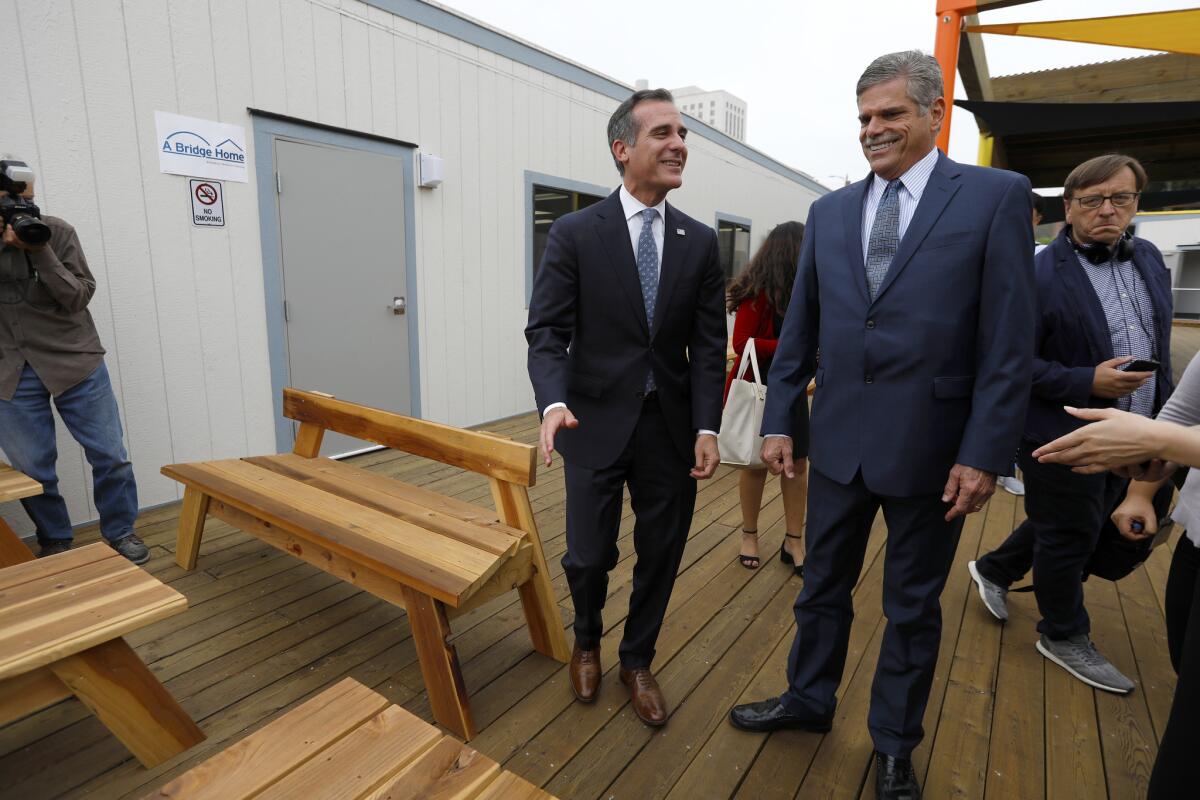
John Maceri of the People Concern, which runs the new shelter, said that 45 people are eager to move in and that there is a waiting list.
âThis is not just about the 45 individuals, itâs about the next 45 individuals and the next after that,â Maceri said. âItâs going to make a dent.â
Szabo said the stepped-up enforcement will begin 30 days after the El Pueblo shelter opens. Cleanup crews, some of which include police, will be present five days a week.
The city has budgeted nearly $32 million for various homeless-related cleanups this year, said Elena Stern, a Department of Public Works spokeswoman.
The shelters are supposed to shut down after three years, but that could be too soon, advocates warned.
Staying open indefinitely would be expensive.
New York City, which keeps almost all of its 61,000 homeless people indoors, spends $1.8 billion a year on its shelter system. The average wait for permanent housing is about a year, said Giselle Routhier, policy director for the cityâs Coalition for the Homeless.
Officials in Philadelphia opened several shelters last year to meet an outbreak of street encampments stemming from the opioid crisis, said Liz Hersh, director of the cityâs Office of Homeless Services. The sites quickly filled, and the city closed two camps, Hersh said.
But the homeless street count continued to climb, she said, adding, âWe knew we could do everything right and still see the numbers go up.â
Los Angeles opened an emergency homeless campsite on skid row more than three decades ago. The shelter was chaotic, and âpeople walked out the gate and were still homeless,â said former Homeless Services Authority Commissioner Mike Neely. The city will need backup from mental health, social services, veteransâ and other systems to move homeless people from shelters to housing, he said.
âWhatâs the end game?â Neely asked. âWill it be different this time? I sure hope so.â
Twitter: @geholland
More to Read
Sign up for Essential California
The most important California stories and recommendations in your inbox every morning.
You may occasionally receive promotional content from the Los Angeles Times.


